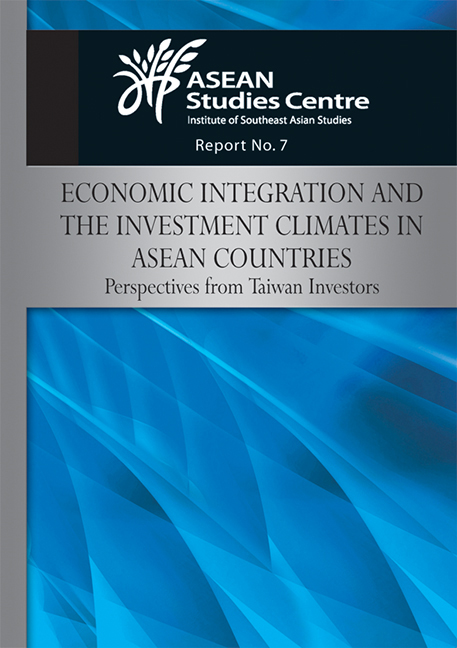 Economic Integration and the Investment Climates in ASEAN Countries
Economic Integration and the Investment Climates in ASEAN Countries Book contents
- Frontmatter
- Contents
- Introduction
- I Economic Integration and the Investment Climates in ASEAN Countries: Perspectives from Taiwan Investors
- Background of the Symposium
- Opening Remarks
- Session 1
- Session 2
- Session 3
- Questions and Answers
- Conclusion and Policy Suggestions
- II Background Papers
- Annex I: Programme of the Symposium
Session 2
from I - Economic Integration and the Investment Climates in ASEAN Countries: Perspectives from Taiwan Investors
Published online by Cambridge University Press: 21 October 2015
- Frontmatter
- Contents
- Introduction
- I Economic Integration and the Investment Climates in ASEAN Countries: Perspectives from Taiwan Investors
- Background of the Symposium
- Opening Remarks
- Session 1
- Session 2
- Session 3
- Questions and Answers
- Conclusion and Policy Suggestions
- II Background Papers
- Annex I: Programme of the Symposium
Summary
17. The first speaker of Session 2, Mr Rodolfo C. Severino, Head of the ASEAN Studies Centre (ASC) at the Institute of Southeast Asian Studies (ISEAS), Singapore, stressed that, for obvious reasons, “Taiwan and ASEAN as a whole cannot enter into government-to-government commitments such as those in FTAs.” He, however, gave an account of the ASEAN Economic Community (AEC) and discussed how Taiwanese and other foreign companies would profit from investing in or otherwise dealing with that community.
18. In December 1997, ASEAN leaders issued ASEAN Vision 2020, partly in response to the Asian financial crisis. In 1992, the region had entered into an agreement to reduce tariffs on intra-ASEAN trade to minimal levels, and to remove non-tariff barriers to that of trade. Thereafter, ASEAN leaders adopted several action plans and committed themselves to intensifying ASEAN economic cooperation and regional economic integration.
19. At their summit meeting in October 2003, the ASEAN leaders issued the second Bali Declaration of ASEAN Concord, in which they envisioned “ASEAN as a single market and production base, turning the diversity that characterises the region into opportunities for business complementation (and) making … ASEAN a more dynamic and stronger segment of the global supply chain”. In November 2007, in a “blueprint” for the ASEAN Economic Community, the leaders defined the nature of that community — “a single market and production base” and a region that was competitive, equitably developed, and “fully integrated into the global economy”. They moved the deadline for its achievement forward from 2020 to 2015.
20. Thus, most building blocks for regional economic integration were already in place. The tariff-cutting exercise was almost done. While the implementation of the other integration measures was progressing slowly, all these arrangements signalled to the international community the importance that the ASEAN governments placed on regional economic integration and directed the attention of the business communities to the opportunities that trade and investments between their countries offered to them.
- Type
- Chapter
- Information
- Economic Integration and the Investment Climates in ASEAN CountriesPerspectives from Taiwan Investors, pp. 8 - 13Publisher: ISEAS–Yusof Ishak InstitutePrint publication year: 2009
